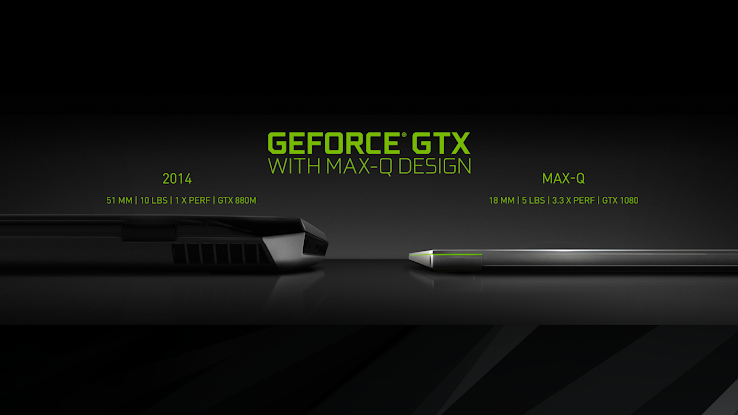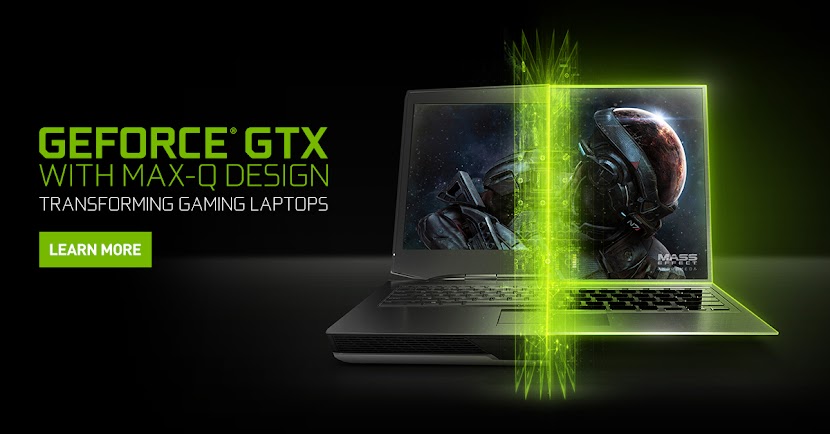Nvidia Geforce GTX 1080 (Laptop) Max-Q Design Review
INTRODUCTION
The Nvidia Geforce GTX
1080 Max-Q from Nvidia is part of the current generation of Nvidia Pascal graphics
chips. It is a powerful high-end graphics card for notebooks. The test shows
that it works well for more than just gaming laptops, which is what it was made
for. Depending on the manufacturer and other equipment, configurations with
this graphics solution can be bought for around 1,900 euros right now.
The GP104 chip in the Nvidia Geforce GTX 1080 is part of the powerful
Pascal family. It is made with a 16-nanometer process, and it has 8 GB of
GDDR5X graphics memory. This is linked together by a memory bus with a width of
256 bits and a theoretical memory bandwidth of 320 GB/s. The GP 104 chip has
2,560 shader units, a core clock that can go up to 1,708 MHz, and a memory
bandwidth that is, in theory, 320 GB/s.
The graphics chip that was tested is part of the revised Max-Q model
series. Nvidia has made this graphics solution more efficient, so it can be
used in thin gaming laptops that are also supposed to be quiet and use less
power. On the product page, Nvidia says that the maximum operating noise should
not be louder than 40 dB(A).
See Also : Max-Q designed thin, fast, and quiet GeForce GTX laptops are now available.
This doesn’t seem to be a rule that notebook makers have to follow,
since neither the Alienware 15 R3 nor the Omen 15 by HP that we tested before
work very quietly when they are being used. In gaming mode, the Alienware 15 R3
gets as loud as 47.9 dB(A) and the Omen 15 by HP gets as loud as 46.4 dB(A) (16
cm distance to the front edge of the notebook case).
* Part of the technical information:
1. GP104 chip for graphics (Pascal generation)
2. Max-Q design
3. Process for making 16nm
4. 2,560 shader units; Max Core Clock of 1708MHz
(Alienware 15 R3)
5. 8GB of GDDR5X video memory
6. The memory clock is 1,251 MHz
7. Memory bus with 256 bits
8. 300 GB/s of memory speed
9. DX 12 OpenGL Volcano API Nvidia Optimus (not with
Nvidia G-Sync)
10. DisplayPort 1.2 is ready for virtual reality (VR).
* Information about how the test system works:
1. Alienware 15 R3 Intel Core i7–7820HK@4.2GHz Nvidia
Geforce GTX 1080 Max-Q Theme 256GB SSD and 1TB HDD
2. Full HD IPS display
3. In a few days, you’ll be able to read the full test
report on the Alienware 15 R3.
Tests of the Nvidia Geforce GTX 1080
The best scores show that the Nvidia Geforce GTX 1080 is the most
powerful graphics card for gaming laptops right now. It’s exactly where it
should be in the Alienware 15 R3, but the tight dimensions of the 15-inch case
and the powerful Intel Core i7–7820HK CPU push the thermal limits to their
limit. The bottom line is that the Nvidia Geforce 1080 only has to lose to a
competitor in a few areas, like professional CAD programmes.
DirectX: When software based on Microsoft’s DirectX interface is used,
high-performance graphics chips for gaming feel the most at home. Of course,
this is mostly about games, but it also includes some professional construction
apps like 3dsMax or Showcase.
The different 3DMark tests cover the different versions of DirectX. In
3DMark Cloud Gate (DX9), the Nvidia Geforce GTX 1080 Max-Q gets 26,868 points,
3DMark Firestrike (DX11) gets 14,323, and 3DMark Time Spy gets 5,730. The
Nvidia Geforce GTX 1080 Max-Q stands out from the Nvidia Geforce GTX 1070
because it performs about 10 to 25 percent better.
OpenGL
In Cinebench R15 64-bit OpenGL Shading, the Nvidia Geforce GTX 1080 gets
139 fps. The Quadro M2200 from Nvidia can do 111 fps, and the Radeon RX560 from
AMD can also do 103 fps.
OpenGL (optimised, workstation CAD) (optimized, workstation CAD)
On the other hand, if you want to use the Nvidia Geforce GTX 1080 Max-Q,
which was made for consumer tasks, for professional CAD tasks, you need to look
very closely at what kind of software it is. When OpenGL-optimized programmes
are used, the Geforce, which has a lot of great hardware, can’t keep up with
professional graphics cards like the Nvidia Quadro or the AMD FirePro/Radeon
Pro. You also have to deal with driver and stability issues, since the
professional drivers, which have been optimised for smooth interaction, can’t
be used with Geforce and Radeon hardware.
The Nvidia Geforce GTX 1080 Max-Q has clear weaknesses in the
SPECviewperf.12 benchmark, especially in Catia, Creo, Siemens NX, and
Solidworks. Even the very old AMD FirePro W4190M can beat the Siemens NX with a
frame rate about 2.5 times faster. With programmes like 3dsMax and Showcase
that use DirectX as their graphics interface, the Nvidia Geforce GTX 1080 is
able to get the most out of its hardware. There are no special optimizations
for the professional chips’ OpenGL drivers. Maya also works well with the
Nvidia Geforce GTX 1080. Here, it is twice as fast as Nvidia’s Quadro P4000 at
doing calculations.
OpenCL & Nvidia CUDA
Through the OpenCL
or Nvidia CUDA interface, graphics chips can also be used for many other tasks
that require a lot of computing power. This includes things like conversions,
image processing filters, video filters, encrypting and decrypting data,
financial analysis, and scientific calculations.
Putting these
tasks on the graphics chip instead of the processor frees up the processor and
gives a not-insignificant speed boost. I tested the areas of financial
analysis, encryption, image processing, and scientific calculations. As
expected, the Nvidia Geforce GTX 1080 also performs best in this area of
testing.
Games
I used several
games that were hard to judge the gaming performance. Here, compared to the
Nvidia Geforce GTX 1060 Max-Q, the Nvidia Geforce GTX 1080 Max-Q can raise the
bar even higher. With the Alienware 15 R3’s native display resolution of
1920x1080 pixels, all tested games can be played without any restrictions.
Here, you don’t have to worry about performance limits ruining the fun of the
game if you use the highest quality settings.
Games like Deus
Ex: Mankind Divided, The Witcher 3, and Total War: Warhammer 2 that need
specific hardware only show how limited it is when a high-resolution 4k screen
is connected. With 3820x2160 pixels, you sometimes have to turn down the
details.
The Nvidia Geforce
GTX 1070 is the next level down in performance for laptops. Games look great on
notebooks with this, and the FullHD resolution works well for them as well. At
the moment, these gamers start at 1,500 euros, making them about 400 euros
cheaper. One of these is the Asus ROG Strix GL502VS. Another is the MSI
GE72MVR.
Virtual Reality: Nvidia Geforce GTX 1080 Max-Q
The powerful GPU
is good for any VR tasks that might come up. Futuremark’s goal for a PC that is
VR-ready is 5,000 points. With 9022 points in VRMark Orange, this limit is
clearly passed, and it is even enough to be around 3600 points ahead of the
Nvidia Quadro P4000 in the Lenovo ThinkPad P71. The lead is 3,300 points over
the Nvidia Geforce GTX 1060 Max-Q.
Cuts to the Clock
In the notebook
market, the stability of the graphics performance always depends on the cooling
system that each notebook has. Manufacturers also sometimes limit the
performance of the graphics and/or CPU at full load so that they can stay
within the thermal limits. The HWinfo tool shows that the GPU clock frequency
in the Unigine Heaven 4 stress test on the Alienware 15 R3 tested here stays
between 1468 MHz and 1670 MHz, even after an hour of running. In the middle,
the speed can go up to over 1,700 MHz. The test notebook’s cooling system then
makes a constant 48.4 dB level of sound pressure (A).
In battery mode,
the performance is cut by more than 80%, just like the Nvidia Geforce GTX 1060
in the HP Omen 15. Then, the clock speed of the GPU is usually between 1290 MHz
and 1366 MHz. The clock sometimes slows down to 1,136 MHz, but then it speeds
up again and goes over 1,400 MHz. Cinebench R15 OpenGL Shading only gets 29 fps
instead of 139 fps, and Unigine Heaven Extreme only gets 30 fps instead of 126
fps.
This has to happen
to keep the battery from draining too quickly and getting too hot. Also, the
runtime at full power consumption would be so short that it wouldn’t be useful.
This behaviour can be very different depending on how the notebook is designed,
how big the battery is, and how the manufacturer tunes it. It is not
necessarily unique to the Nvidia Geforce GTX 1080 Max-Q.
Nvidia Geforce GTX 1080: In conclusion
The Nvidia Geforce
GTX 1080 Max-Q is a high-performance graphics chip for notebooks. It can play
all tested games smoothly at a resolution of 1,920 x 1,080 pixels with the
highest quality settings. Even in some professional applications, the consumer
GPU does a good job and sometimes even does a better job than professional
chips that have been used for years.
The Nvidia Geforce
GTX 1080 Max-Q reaches its performance limit when very demanding 3D games or
other demanding tasks with the highest quality settings and high-resolution
displays are used. Here, you still need to move one of the sliders to get a
smooth enough display.





Comments
Post a Comment